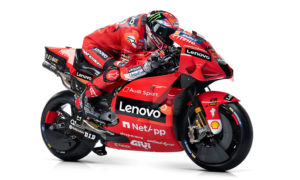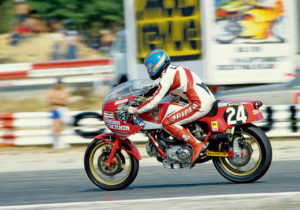Virginio Ferrari, Marco Lucchinelli and Franco Uncini: at the turn of the seventies and eighties, the three musketeers of Italian motorcycling in the queen class.
They illuminated the void left by the retirement of Giacomo Agostini,inserting an important parenthesis in the years of domination of American and Australian riders.
If Marco and Franco actually had consecration, winning the title of the 500class, respectively in 1981 and 1982, the season in the GP that Virginio Ferrari raced in 1979 served as a splendid preamble to the triumphs of the other two.
That year, in fact, Kenny Roberts won, but Virginio was able to contest the title until the last dramatic race of Le Mans, where the Italian stumbled into a ruinous fall. He even feared for his life, but fortunately that was only a parenthesis in pellegrino Parmense’s long career.

Virginio’s sporting history intersects at double wire with that of Ducati, as a rider and as a Team Manager: ” Ducati was my first racing bike: it is said thatthe first love never forgets! – takes to telling Ferrari – So, if you want, I feel connected to the double-edged brand, more for this than for what it represented for me afterwards. In 1975, the year I had passed Senior, I was a young man of good hopes and that ducati 450 single-cylinder I had bought it from Gianni Corbinati, a rider who had had a decent career, coming to the threshold of professionalism.”
Virginio remembers the first race on that bike: “He was in Vallelunga. I remember that, although there were honda-patons and suzuki titans around, my Ducati allowed me to highlight myself, even if there was talk of placements. This earned me the card to play later: it was Farné, on the recommendation of the journalist Bruno De Prato, who hired me for endurance races with the 860 in conical pairs. Franco was the heart and action of the Racing Department of Borgo Panigale.“
Virginio was already racing in the Grand Prix with Paton, but Farné’s call allowed him to make international experience.
So Ferrari, fresh winner of a Formula 1000 race in Misano, riding a Laverda SFC, is invited by Farné to try the Ducati 860 on the occasion of the Mugello 1000 Kilometers:“That race was to be run by the Cannellas-Grau pair; In practice, after a selection of different names, I had to replace Cannellas and team up with Benjamin Grau. To pay Franco back, I did the fast lap and we won the race. That success earned me gallons on the field and the couple, from then on, was called Ferrari-Grau. It was 1975.“
The period on the 860 in pairs will give him other satisfactions:“Farné made me do more runs. The 1000 Kilometers of Misano together with Carlo Perugini, which we won in 1976; then we came second in the 1000 Kilometers that took place in Le Mans. In the races that took place over the distance of 1000 kilometers we were extremely competitive, while in the 24 Hours I could never not only win, but even get to the end. The Achilles heel was the conical pair of the Ducati engine that, around two or three in the morning, went into gruel.“
Ferrari is therefore in the limelight and the years of its long militancy in the World of Grand Prix come. It is important to note that, at the end of this period, Ferrari enters and leaves the orbit of the Cagiva.
Having the Castiglioni brothers purchased the Ducati, it is not uncommon to see riders engaged in GP with the Cagiva also riding the twin-cylinders of Borgo Panigale.
In fact, in 1985 Virginio raced in the Italian F1 championship with the Ducati 750 driven by the twin-cylinder Pantah. “It was a beautiful bike, also because we had the maximum technology available at the time. He had the 16″ wheels, of which I was the most experienced connoisseur, having tested them at the time of Team Gallina, in 1977. It must also be said that there was no longer the conical pair to command the distribution, but the toothed strap. This will prove fundamental for the reliability of the Ducati.“
With the 750 F1, Virginio will win at Monza and Mugello. 1986 is an important year because Ferrari, together with Garriga and Lucchinelli, brings to its debut the prototype ducati with four-valve engine designed by Ingegner Massimo Bordi.
“It was a beautiful experience, also lived under the watchful eyes of Fabio Taglioni. The bike had immediately shown signs of surprising quality.“
We asked Ferrari what were the peculiarities that the riders immediately perceived. “The bike was a bit like it. You still had to go, in quotes, to leather to understand what the defects and needs of the engine were. – Ferrari continues in the story – We riders directed the technicians about the development of the injection, with years of experience with two-speed engine carburetion. So we got to the Paul Ricard with a fairly pointy bike.“
Many will be wondering what atmosphere was breathed that weekend at the Bol d’Or.
“It must be said that you did not do all the communication work that is done today. – says Virginio – We went there with the new four-valve engine, but we did it discreetly, because we didn’t know what the backlash might be if things didn’t go right. It was said, but not too much. It was intended to be informed, but no proclamations had been made. It was a fair and reasonable choice: I remember that at four in the morning I give the change to Lucchinelli in the driving of the bike. In the moments that pass, while the mechanics refuel and check the bike, Marco pats me on the shoulder and says: – Go Iron, all right! – I jump on the bike and leave. I wasn’t out of the pits yet when, accelerating, I feel a vibration on the platforms that literally makes my feet slide away. I think of Marco’s phrase and dedicate a sound to him! I ride four or five laps with the engine vibrating in fear. I get to some point in the Mistral straight, at 280 km per hour, and I have a shake on my hands. The engine makes an incredible din. I insert the clutch and remove the gas. The thrust I had allowed me to walk three more turns, then, cutting through the escape spaces, I pushed the bike for two hundred meters to the pits. I arrived a little rushed to see that the adventure had ended with a connecting rod outside the carter.“
So the adventure ended with the bike in Ferrari’s hand, but who was the three who started? “Me: the order was Ferrari, Garriga and Lucchinelli. By the way, there is a funny anecdote to tell: after the retreat I went to Marco to tell him: everything is fine, huh? And he, feeling the vibrations, everything translated said to me: I could not take any more, I had a terrible evil in my hands, I hoped it would break, I said it just to laugh!“
In fact, Virginio smiles. Then came the bimota years,the title of F1 class world champion in 1987,the last year before, from this series, the SBK class was born.
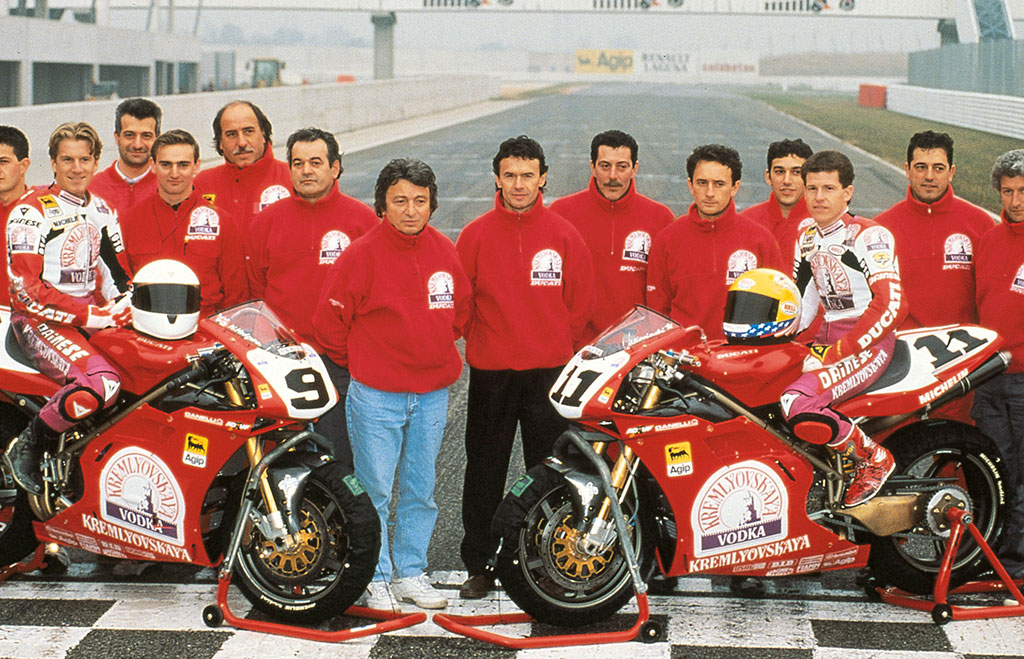
Bimota takes him to the world title, but distances him from Ducati.
Only in 1991 will he be able to race again with the bike of Borgo Panigale: he is entrusted, in silence, with an evolution engine to be tested:“They didn’t want to give that engine to a riders too much in the spotlight and, therefore, they thought of me. So, taking advantage of the fact that I was back running with an 888, Mugello entrusted me with the engine they wanted to experience in the race.“
In 1991, lucchinelli was driving the official Superbike team. Ceparana’s pilot, however, had personal events and it was in that year that Castiglioni asked Virginio to replace him.
“I refused: I would not take the place of a friend in distress.“
The careers of Marco and Virginio, seasoned with a healthy rivalry, often intertwine and represent an example to follow on how you can be adversaries and friends at the same time.
Thus, in 1991 it was Uncini who took the reins of the Ducati team in the series derivatives championship. It was roche’s turn and, finally, Virginio’s turn in 1994.
The epic of the Ducati 916 begins. “We started with the testing of this incredible vehicle created by Tamburini at the end of 1993, with Giancarlo Falappa. In 1994 we started by winning straight away. We had the advantage of displacement that allowed us to do the good and the bad weather. It was a wise decision of Massimo Bordi to centennia the increases in displacement. We started at a weight of 145 kg and, when the Japanese imposed weight gain, since I had decided to mount the data acquisition (Ducati was the first to do so in Superbike, ed), to get to the 155 kg imposed we had to put only two kilos of ballast. With telemetry, our progress was much faster. Then, when they forced us to reach 162 kg, we increased the displacement to 955 cc, recovering the gap. It is also because of these tug-of-war with the displacement that the 916 has had such a long career.“
These are the years of the explosion of Fogarty’s domain, unfortunately marked at the beginning bythe Falappa incident:“Giancarlo could have been the winning man in this category: unfortunately he was stopped by fate.“
Virginio gets serious and adds: “I have to open a painful page. As for the accident he had at Zeltweg in 1992, Giancarlo had difficulty changing with his foot. We fitted him with a button change, on the left handlebars, so that he could use it in the circuits where he was mainly turning left. When he fell into private rehearsals at Albacete it was not the command system that failed, as has been written, but it was the gearbox that planted itself.“
Ferrari’s management will bring the two titles won by Carl Fogarty,in 1994 and 1995, and will end with the title touched by Corser in 1998.
Ducati World Archive Photo
Virginio Ferrari: the master of the ring
Ferrari’s GP career began in 1975, at the GP of the Nations, with the Paton 500. Already in 1976 it will be third, right in the Italian stage, held at Mugello, behind Sheene and Read. The following year it was imola’s place in the “Nations“.
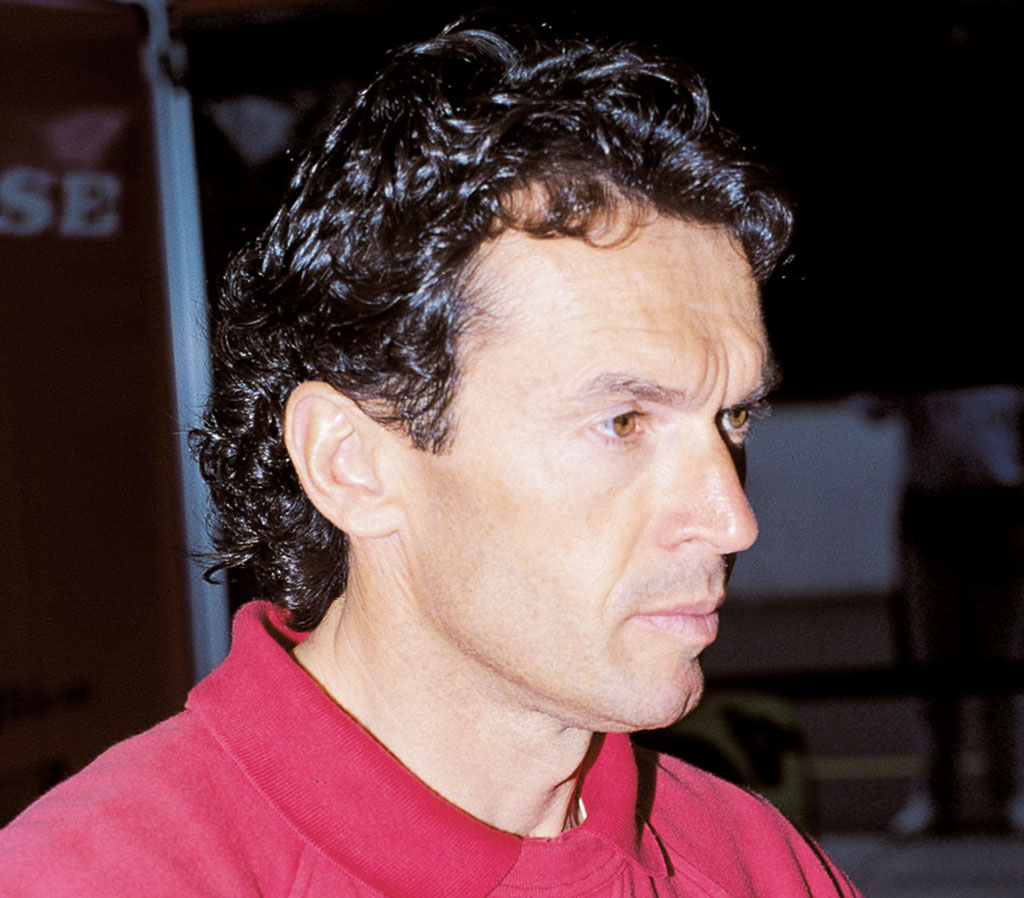 Virginio will be second behind Sheene. It is now more than a promise and in 1978, within Team Gallina, he started with the role of second driver, with an unofficial motorcycle, companion of the American Steve Baker. The Italian rider with the unmistakable yellow and green helmet will often be faster than his captain,deserving the official bike in the last race of the season at the Nurburgring.
Virginio will be second behind Sheene. It is now more than a promise and in 1978, within Team Gallina, he started with the role of second driver, with an unofficial motorcycle, companion of the American Steve Baker. The Italian rider with the unmistakable yellow and green helmet will often be faster than his captain,deserving the official bike in the last race of the season at the Nurburgring.
In practice, Suzuki Heron GB’s sporting director, Martin Ogborne, sets up a motorcycle using spare parts from Barry Sheene’s bike.
Ferrari did not waste the opportunity: third time in practice, he won the race also doing the fast lap, deserving the title and ring of “Maestro del Ring“.
The dangerous German track, on which it ran every other year, had already been the scene of beautiful feats of the young Ferrari: in 1976, it was his best time in practice, with an attached track record. In the race a grippaggio took him off the scene after a few kilometers. “It was the fear of dying on that track that perhaps had made me focus on the points where I could make a difference, – says Virginio – a kind of survival instinct. All the curves were good for killing themselves. That track was a permanent Tourist Trophy!“
The 1979 season will be for Virginio that of consecration: he has the official Suzuki RG 500, wins in Assen after a memorable duel with Barry Sheene, finishes second in the championship behind Kenny Roberts and his Yamaha.
It is also the year of the sincere commitment to safety, which sees the Parma rider lead the revolt of the big ones boycotting the Belgian GP. Virginio believes in the creation of an alternative championship, the World Series, untied by the World Federation. Nothing was done about it, because of a front that seemed compact and that, instead, was not. The following year, he moved to Yamaha of Team Zago, and found himself on foot for the vicissitudes of the team.
Virginio enters the orbit of the Cagiva dei Fratelli Castiglioni and runs the world championship riding the Italian bike in 1981, suffering the defects of youth of the bike. He returned to prominence in 1982: the official Suzuki team wanted him alongside Randy Mamola. An accident, in pre-season testing, on the Willow Spring circuit, will condition much of a season that, in the end, will see him eleventh. He returned to Cagiva in 1983, and in 1984 he was eddie lawson’s teammate in team Yamaha directed by Giacomo Agostini. With his American teammate winning the title, Ferrari came in tenth, collecting a series of withers and disappointments.
In 1985, still under the insignia of Cagiva, the satisfaction of bringing the Italian bike to the third row in the last appointment of Misano was removed. The following year he attempted the adventure in 250, with Honda. Some good placements will lead him to finish fourteenth.
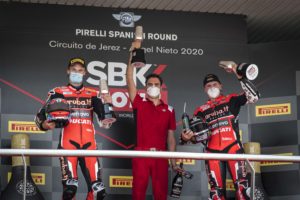
SBK a Jerez: avanti tutta!
A Jerez de la Frontera, seconda tappa del campionato SBK, si ri-accende lo spettacolo con Ducati protagonista. Doppietta di Redding e secondo posto in gara 2 per Davies.
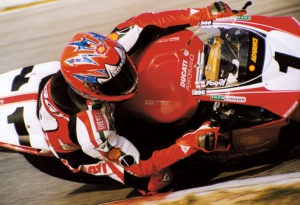
Carl Fogarty: la carriera del “King” e la sua storia in Ducati
E’ uno dei piloti più vittoriosi nel mondiale Superbike. Ecco la storia di Carl Fogarty “King Carl” e della sua Ducati.


